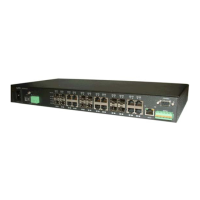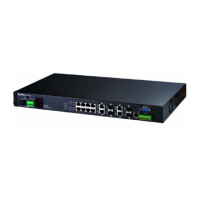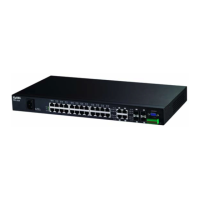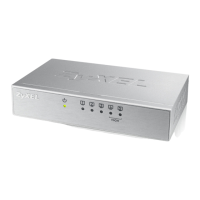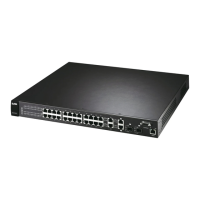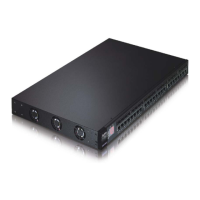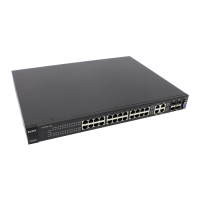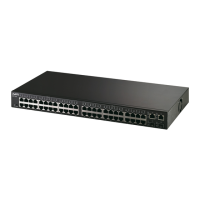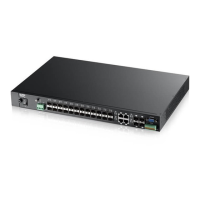
Do you have a question about the ZyXEL Communications MGS3520 Series and is the answer not in the manual?
| Brand | ZyXEL Communications |
|---|---|
| Model | MGS3520 Series |
| Category | Switch |
| Language | English |
Introduces the main features and applications of the Switch, covering its Layer 2 capabilities and management methods.
Describes the Switch as an ideal solution for small networks with rapid growth, supporting heavy traffic users.
Illustrates how the Switch connects different company departments, alleviating bandwidth contention and server bottlenecks.
Highlights the Switch's suitability for connecting high-bandwidth networks cost-effectively, retaining existing infrastructure.
Explains VLANs for partitioning a physical network into multiple logical networks and improving performance.
Details the Switch's support for IPv6 features, including address assignment, Neighbor Discovery Protocol, and dual stack.
Outlines the various methods for managing the Switch, including Web Configurator, CLI, FTP, and SNMP.
Provides essential security and management practices, such as changing passwords and backing up configurations.
Describes the two primary installation methods: desktop and rack-mounted, with ventilation notes.
Provides a step-by-step guide for desktop installation, focusing on environment and clearance.
Details the process of mounting the Switch on a standard EIA rack, including requirements.
Details the components of the Switch's front panel, including ports, LEDs, and slots.
Explains the meaning and status of each LED indicator for monitoring and troubleshooting.
Introduces the HTML-based web configurator for Switch setup and management.
Provides instructions for accessing the web configurator and logging in with default credentials.
Describes the navigation panel and quick links within the web configurator interface.
Explains how to save configuration changes to non-volatile memory to retain them after power cycles.
Warns about methods that can block access to the Switch via in-band management.
Details how to reset the Switch to factory defaults or reload a configuration file.
Recommends logging out after management sessions for security reasons.
Explains how to access online help for detailed screen descriptions and supplementary information.
Lists the configuration steps for initial setup: creating VLAN, setting port VID, and configuring management IP.
Guides on configuring the Switch IP address, default gateway, and management VLAN ID.
Provides a step-by-step guide for configuring DHCP snooping to assign IP addresses to devices in a specific VLAN.
Explains how to configure the Switch to forward DHCP client requests to a specific DHCP server.
Details configuring PPPoE Intermediate Agent to pass subscriber information to a PPPoE server.
Demonstrates how to shut down a port for loops or excessive ARP requests and configure automatic recovery.
Guides on setting up a guest VLAN for unauthenticated clients to access limited network resources like the Internet.
Explains how to prevent communication between ports in a VLAN while allowing access to uplink resources.
Describes the web configurator's home screen displaying port statistical summaries.
Explains how to view port statistics by accessing the Status screen.
Covers viewing system information like firmware version, temperature, fan speeds, and voltage.
Details configuring general settings such as system name, location, contact person, and time.
Explains VLANs for network partitioning, isolation, security, and performance enhancement.
Guides on configuring VLAN types (802.1Q or Port Based) and other global switch parameters.
Covers configuring the Switch IP address, default gateway, DNS, and management VLAN ID.
Details configuring individual Switch port settings, including speed, duplex, and flow control.
Explains configuring IPv6 interfaces, including static VLANs, for managing the Switch.
Provides instructions for viewing IPv6 interface status and configuring management IPv6 addresses.
Explains tagged VLANs, their frame format, and how VLAN IDs associate frames with specific VLANs.
Details automatic VLAN registration using GARP and GVRP protocols.
Enables frames belonging to unknown VLAN groups to pass through a port, useful for VLAN setup on end devices.
Guides on selecting the VLAN type (802.1Q or Port Based) in the Switch Setup screen.
Explains static VLANs for deciding frame forwarding based on VLAN tags or blocking traffic.
Allows grouping traffic into logical VLANs based on source IP subnet, enhancing priority assignment.
Groups traffic into logical VLANs based on specified protocols, allowing priority assignment per protocol.
Assigns untagged packets to VLANs based on source MAC address, classifying traffic and enabling priority assignment.
Covers setting the MAC address learning limit on a per-port and per-VLAN basis.
Details port-based VLANs where forwarding decisions are based on destination MAC address and associated port.
Discusses configuring forwarding rules based on MAC addresses of devices on the network.
Explains manually entering static MAC addresses to reduce broadcasting and enhance port security.
Introduces static multicast MAC addresses and how to forward multicast frames to specific ports.
Provides instructions for configuring rules to forward specific multicast frames to designated ports.
Guides on configuring the Switch to filter traffic based on source/destination MAC addresses and VLAN group.
Explains (R)STP's role in detecting and breaking network loops and providing backup links.
Describes the Spanning Tree Protocol status screen, which varies based on the implemented standard.
Guides on activating STP modes (RSTP, MRSTP, MSTP) via the Spanning Tree Configuration screen.
Details how to configure RSTP settings for faster spanning tree convergence.
Explains how to view the RSTP status screen, available after activating RSTP.
Provides instructions for configuring MRSTP, allowing multiple spanning trees and port assignments.
Describes how to view the MRSTP status screen, available after activating MRSTP.
Guides on configuring MSTP, including bridge priority, Hello Time, and port configurations.
Defines bandwidth control as setting maximum allowable bandwidth for incoming and outgoing traffic on a port.
Guides on configuring bandwidth control settings via the Bandwidth Control screen.
Explains how to limit broadcast, multicast, and DLF packets per second to reduce network storms.
Introduces port mirroring for copying traffic flows to a monitor port for analysis without interference.
Details selecting a monitor port and specifying traffic flow for local port mirroring.
Explains setting RMirror VLAN ID, mirroring port, and traffic flow for remote port mirroring source devices.
Guides on specifying RMirror VLAN ID and monitor port when the Switch is the destination device in remote mirroring.
Explains logically aggregating physical ports into one logical, higher bandwidth link.
Details dynamic link aggregation using IEEE 802.3ad standard and LACP for negotiating trunk groups.
Describes how to view the Link Aggregation Status screen, showing group ID and enabled ports.
Guides on configuring static link aggregation, including group ID and traffic distribution criteria.
Explains LACP configuration for dynamic link aggregation.
Provides a practical example of creating a static port trunk group.
Validates client access to ports using external servers via 802.1x or MAC authentication.
Guides on activating port authentication methods and configuring RADIUS server settings.
Allows only packets with learned or static MAC addresses to pass through a port, enhancing security.
Provides instructions for setting up port security, including disabling MAC learning for maximum security.
Defines a profile as saved settings for ranges of ports, IP addresses, VLANs, or socket ports.
Allows access and configuration of profiles for VLANs, IP addresses, ports, and socket ports.
Covers viewing, managing, and creating VLAN range profiles.
Details managing and creating port range profiles, selecting specific ports or ranges.
Guides on creating and managing IP address range profiles for source or destination IP addresses.
Covers creating and managing socket port range profiles, specifying source or destination socket ports.
Explains Quality of Service (QoS) for prioritizing traffic and classifying traffic into flows based on criteria.
Guides on defining classifiers to specify actions (policy) on traffic matching defined rules.
Explains how policy rules ensure traffic flows receive requested treatment based on classifier criteria.
Details configuring policy rules, including actions like forwarding, dropping, or setting priority.
Introduces queuing methods for solving performance degradation during network congestion.
Guides on configuring queuing algorithms (SPQ, WFQ, WRR) for outgoing traffic.
Explains how service providers use VLAN stacking to distinguish multiple customer VLANs.
Describes the three VLAN stacking port roles: Normal, Access Port, and Tunnel Port.
Details the structure of a VLAN tag, including Type, Priority, and VID fields.
Guides on configuring VLAN stacking, including Port-based Q-in-Q and Selective Q-in-Q.
Introduces multicast as a method for transmitting IP packets to a group of hosts.
Guides on configuring IGMP for IPv4 or MLD for IPv6 and setting up multicast VLANs.
Shows how to display IPv4 multicast group information.
Provides information on viewing IPv6 multicast group status.
Introduces Multicast VLAN Registration (MVR) for sharing a single multicast VLAN among subscriber VLANs.
Guides on creating multicast VLANs and selecting receiver and source ports for each multicast VLAN.
Explains AAA processes: determining user identity, defining user privileges, and recording user actions.
Guides on enabling AAA, configuring server settings, and setting authentication priority.
Lists RADIUS attributes supported by the Switch for authentication and accounting.
Details IP source guard's function in filtering unauthorized DHCP and ARP packets using a binding table.
Allows viewing current bindings for DHCP snooping and ARP inspection.
Guides on managing static bindings identified by MAC address and VLAN ID.
Provides statistics on the DHCP snooping database, including status and timers.
Details enabling DHCP snooping, specifying VLANs, and configuring the DHCP snooping database.
Allows viewing statistics for ARP packets in each VLAN, including received, forwarded, and dropped counts.
Explains Loop Guard's function in detecting and shutting down ports to prevent network loops.
Guides on enabling the loop guard feature on the Switch, noting compatibility with STP protocols.
Describes mapping private VLAN IDs and priorities to service provider network IDs.
Guides on enabling VLAN mapping functionality through the VLAN Mapping screen.
Details how to configure and edit VLAN mapping rules.
Explains L2PT for tunneling Layer 2 protocols like STP, CDP, and VTP across a service provider network.
Guides on configuring Layer 2 protocol tunneling modes (Access and Tunnel).
Introduces sFlow as a technology for monitoring switched networks and analyzing traffic.
Guides on configuring sFlow agents and collectors for monitoring network traffic.
Explains PPPoE Intermediate Agent's role in helping PPPoE servers identify and authenticate clients.
Guides on configuring the PPPoE Intermediate Agent globally on the Switch.
Details configuring the Switch to provide subscriber information to PPPoE termination servers.
Explains CPU protection to limit control packet rates and protect against DoS attacks.
Describes how features can shut down ports upon error detection and configure automatic recovery.
Guides on configuring error disable related settings.
Allows viewing the status of control packets exceeding rate limits or disabled ports.
Details limiting control packet rates on ports for CPU protection.
Guides on configuring error detection for control packets and the action to take when limits are exceeded.
Covers configuring the Switch to automatically undo actions after errors are resolved.
Explains private VLANs for port isolation within a VLAN, blocking traffic between isolated ports.
Guides on configuring and enabling private VLAN rules for a specific VLAN.
Details how Green Ethernet reduces switch port power consumption using EEE, Auto Power Down, and Short Reach.
Guides on configuring Green Ethernet settings globally and per port.
Introduces LLDP as a Layer 2 protocol for advertising device identity and capabilities on a local network.
Explains LLDP-MED as an extension for media endpoint devices, enhancing discovery for VoIP and applications.
Provides access to LLDP screens, including Local Status, Remote Status, and Configuration.
Displays a summary of LLDP status for the Switch, including Chassis ID, System Name, and Port Information.
Shows a summary of LLDP status for each LLDP connection to neighboring Switches.
Guides on configuring global LLDP settings, including Basic TLV and Org-specific TLV settings.
Covers configuring LLDP-MED parameters for capabilities, network policy, and location.
Details configuring LLDP-MED network policies for applications like voice and video.
Guides on setting up location information for remote devices using geographical and Civic Address coordinates.
Explains using IP static routes for the Switch to communicate with remote management stations.
Guides on configuring static routes via the IP Application > Static Routing screen.
Details configuring static route settings for IPv4 destinations, including IP address and subnet mask.
Explains DiffServ for prioritizing traffic flows based on application types and marking packets with DSCPs.
Guides on activating DiffServ to apply marking rules or IEEE 802.1p priority mapping on selected ports.
Details configuring DSCP to IEEE 802.1p mapping for prioritizing traffic based on incoming DSCP values.
Introduces DHCP for obtaining TCP/IP configuration and configuring the Switch as a server or relay agent.
Guides on configuring DHCP settings globally or on a per-VLAN basis.
Shows configuration settings related to the Switch’s DHCP relay mode.
Explains configuring DHCP relay for clients and servers not in the same broadcast domain.
Details DHCPv6 relay agent functionality for forwarding messages between DHCPv6 servers and clients.
Introduces ARP for mapping IP addresses to MAC addresses and explains how ARP works.
Guides on configuring ARP learning modes (ARP-Reply, Gratuitous-ARP, ARP-Request) for each port.
Provides access to manage firmware and configuration files, including upgrade and backup.
Guides on resetting the Switch to its factory default configuration.
Explains how to save current configuration settings permanently to Configuration 1 or 2.
Details restarting the Switch, loading specific configurations, or scheduling a restart.
Guides on upgrading the Switch firmware to the latest version using dual firmware images.
Explains restoring a previously saved configuration from a computer to the Switch.
Guides on backing up current Switch configurations to a computer for later restoration.
Introduces the Tech-Support feature for logging CPU, memory, and crash reports for issue analysis.
Provides examples of uploading and downloading files using FTP commands.
Describes controlling access to the Switch via console, Telnet, SSH, FTP, Web, and SNMP sessions.
Guides to the main Access Control screen for managing security settings.
Introduces SNMP for managing and monitoring network devices, including agents and managers.
Details setting up login accounts for administrators and non-administrators via the web configurator.
Explains SSH as a secure protocol for encrypted communication between hosts.
Summarizes the secure connection establishment process between SSH clients and servers.
Details SSH version 2 support, authentication methods, and requirements for using SSH.
Explains HTTPS as a web protocol for secure encrypted web page transactions using SSL.
Provides examples of accessing the Switch via HTTPS, including handling browser security warnings.
Allows deciding which services to access the Switch and configuring default service ports.
Enables specifying trusted computers for managing the Switch via services like Telnet, HTTP, and SSH.
Guides on using the Diagnostic screen to check system logs, ping IP addresses, and perform port tests.
Explains the syslog protocol for sending event notification messages to syslog servers.
Guides on configuring system logging settings to send logs to an external syslog server.
Covers configuring a list of external syslog servers and their severity levels.
Introduces cluster management for managing multiple switches through one manager switch.
Describes viewing cluster status, including manager and member switch information.
Guides on configuring clustering management, adding and managing cluster members.
Introduces the MAC Table screen, showing how frames are forwarded or filtered based on MAC addresses.
Guides on viewing and filtering the MAC table entries by condition and sorting criteria.
Introduces ARP for mapping IP addresses to MAC addresses and explains how ARP works.
Guides on viewing IP-to-MAC address mappings and removing dynamic ARP entries.
Introduces the IPv6 Path MTU table and its role in discovering the minimum MTU of links in a path.
Guides on viewing IPv6 path MTU information on the Switch.
Allows copying basic and advanced settings from a source port to destination ports.
Introduces the IPv6 neighbor table and its role in resolving and verifying addresses.
Guides on viewing IPv6 neighbor information on the Switch.
Troubleshoots issues related to power, hardware connections, and LED behavior.
Provides solutions for forgotten IP addresses, usernames, passwords, and access issues.
Addresses issues like losing configuration settings after restarting the Switch.
Lists essential information to have ready when contacting customer support for troubleshooting.
Provides contact details for ZyXEL's corporate headquarters and regional offices.
Lists commonly used services, their associated protocols, port numbers, and descriptions.
Introduces IPv6, its enhanced address size, and features compared to IPv4.
Explains the format of IPv6 addresses and methods for abbreviation.
Describes IPv6 address prefix and prefix length similar to IPv4 subnet masks.
Defines link-local addresses as unique identifiers for devices on the local network.
Explains global addresses as unique Internet identifiers, similar to public IPv4 addresses.
Describes the unspecified address used when a device lacks its own address.
Defines loopback addresses for sending packets to oneself.
Explains multicast addresses providing the same functionality as IPv4 broadcast addresses.
Details IPv6 address and subnet mask composition using hexadecimal notation.
Identifies a physical or virtual interface with a unique 64-bit identifier.
Describes the EUI-64 format for interface IDs, derived from Ethernet MAC addresses.
Explains automatic IPv6 address generation without a DHCP server.
Demonstrates enabling IPv6 using the ipv6 install command and checking IP addresses with ipconfig.
Shows how to enable DHCPv6 client on Windows XP using Dibbler.
Guides on enabling IPv6 and DHCPv6 on Windows 7 via Network and Sharing Center.
Describes DHCPv6 as a server-client protocol for assigning IPv6 network addresses and configuration.
Explains Identity Associations (IA) for managing IP address assignments between DHCP client and server.
Details DHCP relay agent functionality for forwarding messages between DHCPv6 servers and clients.
Explains how IPv6 routers use prefixes received from ISPs for LAN IP address generation.
Defines ICMPv6 for reporting errors and performing diagnostic functions in IPv6 networks.
Describes NDP for discovering IPv6 devices and tracking neighbor reachability using ICMPv6 messages.
States the copyright information for the publication.
Disclaims ZyXEL's liability for product application or use and reserves the right to make changes.
Provides regulatory compliance information for USA, Canada, and the European Union.
Details EU regulations for product and battery disposal and recycling.
Directs users to the ZyXEL website to view product documentation and certifications.
Outlines the product warranty terms, coverage, and exclusions.
Provides instructions for registering products online for firmware updates and information.
Lists ZyXEL's registered trademarks and acknowledges other trademarks used for identification.
Informs about the inclusion of free software distributed under GPL licenses.
